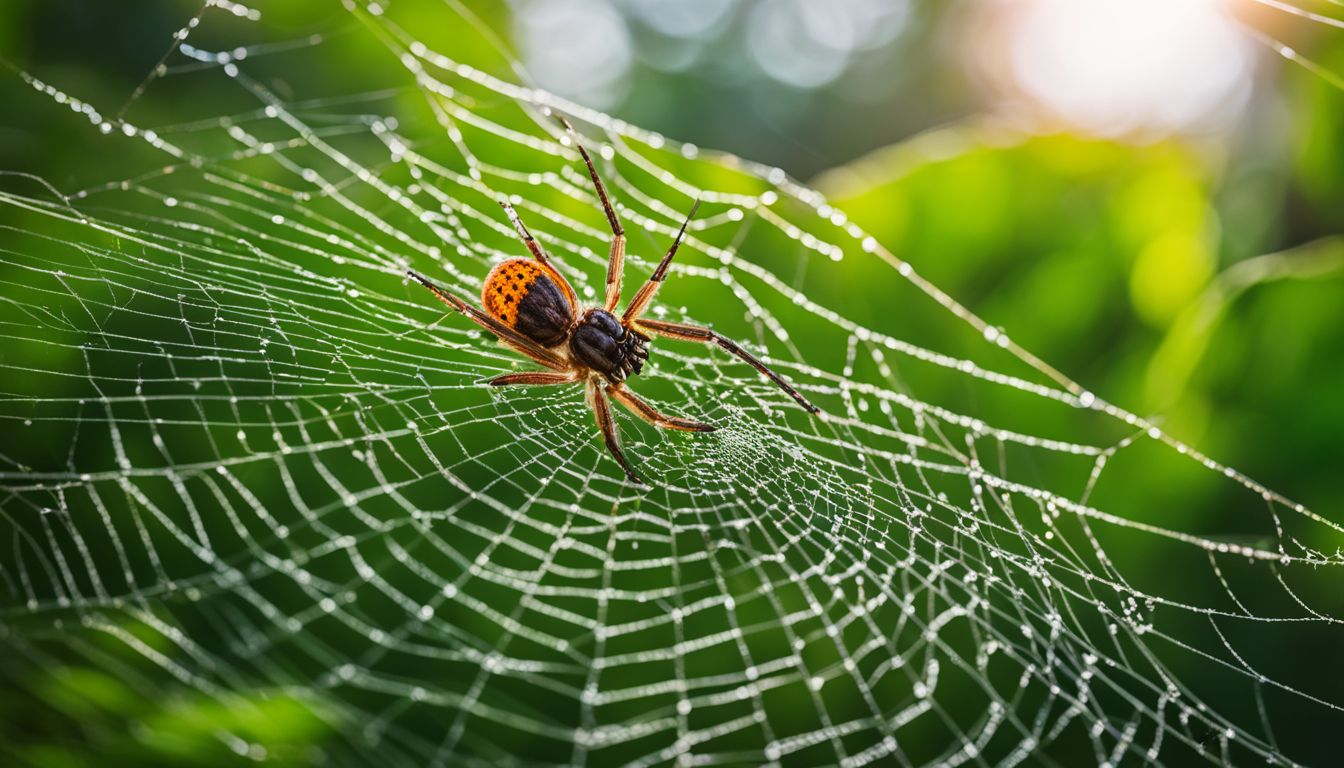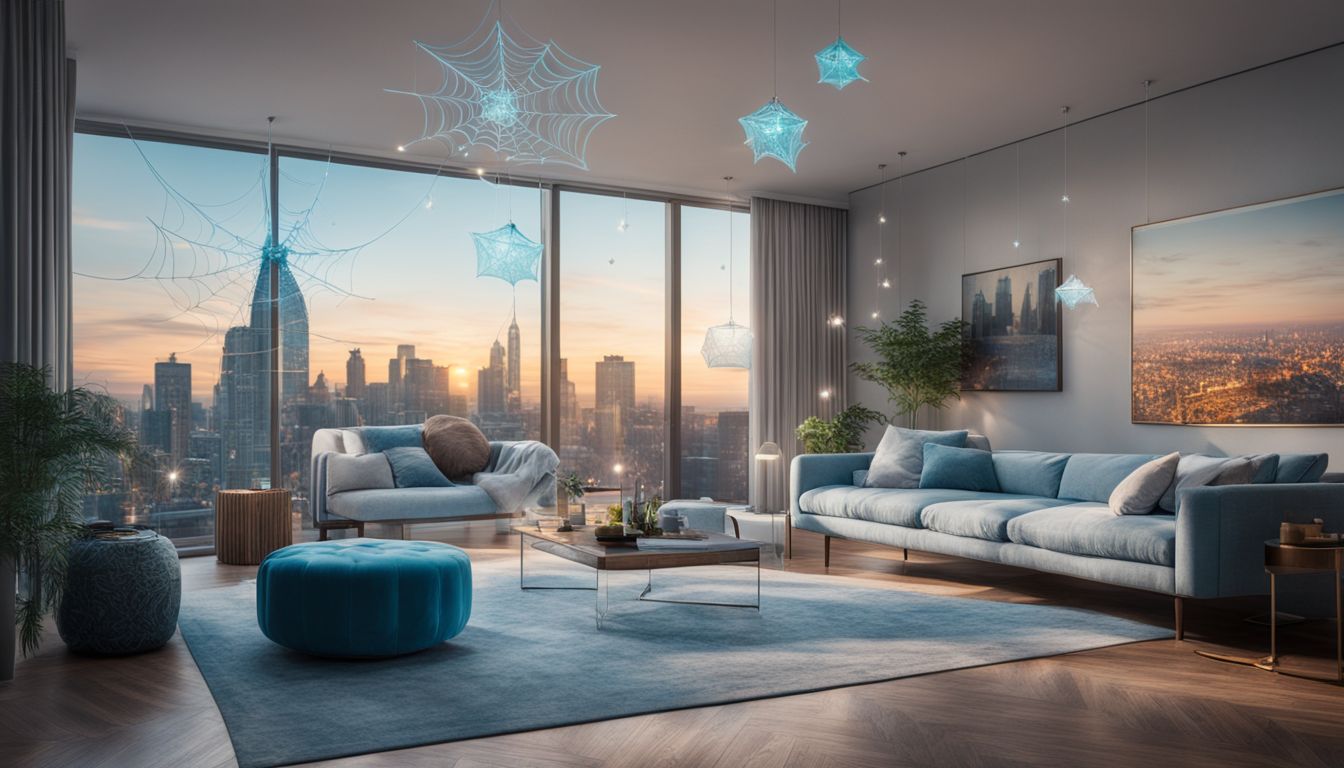Are you noticing more spiders in your home than you’d like? It turns out that these eight-legged creatures may have color preferences, specifically disliking light blue and yellow.
In this post, we’ll explore the surprising world of spider color perception and how you can use this knowledge to keep them at bay. Stay tuned to learn which colors might just be your new best friends in pest control!
Key Takeaways
- Spiders dislike light blue and yellow colors, making them useful for deterring spiders from your living spaces.
- Green is an attractive color for spiders due to their unique vision capabilities, potentially drawing them closer instead of repelling them.
- By incorporating light blue into your environment through curtains, furniture, or paint, you can effectively repel spiders. Additionally, avoiding spider-friendly colors like dark shades and green can help keep these pests at bay.
Understanding Spider Vision

Spiders have a unique perception of color due to their dichromatic vision, which allows them to see a limited spectrum of light. This means they can perceive some colors but not others, making certain hues more appealing or repellent to them.
How spiders perceive colors
Spiders see the world very differently from humans. They have a special kind of vision called dichromatic vision. This means they can only spot two main colors: green and ultraviolet light.
Their eyes have cones that are tuned to these colors. So, while we enjoy a rainbow of shades, spiders focus mainly on green and blue hues.
They don’t notice other colors like we do because their colorblind eyes miss out on reds, yellows, and oranges. Instead, they’re super good at seeing greens which pop out at them in nature.
Next up is learning about the range of light that spiders can actually see!
The spectrum of light they can see
Most spiders have a simple way of looking at the world. They can’t see all the colors humans do. Their eyes are good at picking up green and ultraviolet light. Think about wolf spiders; they only notice ultraviolet and a bit of green.
This means their world looks quite different from ours.
Many eight-legged critters use this basic color vision to get around. It helps them spot food or avoid enemies. Knowing this, we can guess what colors might bug them or draw them in.
Now let’s find out which hues actually make spiders want to stay away!
Colors That Repel Spiders

Spiders are known to have an aversion to light blue, making it a color that can help deter them from your living spaces. On the other hand, green is considered an attractive color for spiders and may draw them closer instead.
The aversion to light blue
Light blue seems to be a color that spiders don’t like. Scientists think this might be because these eight-legged creatures can’t see the full range of colors well. Their eyes are not like human eyes, which have retinal cells for seeing lots of different colors.
Instead, spiders may only pick up on certain shades and the light blue is one they avoid. Some people use this fact to keep spiders away from places where they don’t want them.
You could paint walls or use decorations that are light blue to make your space less inviting for spiders. While we can enjoy all sorts of hues, including blues, our tiny friends seem to prefer staying away from them.
This makes light blue a useful color if you want fewer spider guests in your home!
Green as an attractive color for spiders
The aversion to light blue is interesting, but did you know that green is an attractive color for spiders? Spiders are sensitive to light in the green wavelength, and research shows that they react differently to this color compared to others.
While it may repel bugs, the color green actually attracts spiders due to their unique vision capabilities. In fact, their sensitivity to this particular color makes it important to consider when trying to deter them from certain areas.
Colors That Attract Spiders
Spiders are attracted to dark or bright colors, which mimic the appearance of potential prey or hiding spots. They also have a preference for green, making it an attractive color for them to gravitate towards.
Preference for dark or bright colors
Spiders are more attracted to dark and bright colors rather than neutral ones. The recent study from Nature Communications found that spiders have a preference for these types of colors.
This means if you want to deter spiders, avoid using dark or very bright colored items in your home or garden.
Now we will explore the next section on “Utilizing Color to Deter Spiders“.
The attraction to green
Having discussed the preference for dark or bright colors, it’s interesting to note that spiders are actually attracted to the color green. Research from the University of Cincinnati has found that green is a color that specifically draws spiders, including wolf spiders.
While this may seem counterintuitive as many insects tend to steer clear of green, it remains an important factor to consider when trying to deter spiders from your surroundings.
Green appears to have a distinct appeal for spiders despite its repellent effect on other bugs; this contrasts with their dislike for light blue. So while opting for light blue might be effective in keeping spiders at bay, incorporating green into your environment could potentially attract them.
Utilizing Color to Deter Spiders
Consider incorporating light blue into your environment through curtains, furniture, or paint to repel spiders. Be mindful of avoiding spider-friendly colors like dark shades and green to keep these pests at bay.
Practical ways to incorporate light blue into your environment
- Use light blue curtains or drapes in your windows to discourage spiders from entering your home.
- Consider painting your ceiling or walls with a light blue color to create an environment that spiders find unattractive.
- Place light blue throw pillows or blankets on furniture to add a pop of spider-repelling color to your living space.
- Opt for light blue bedding and linens in bedrooms to deter spiders from making themselves at home in your sleeping areas.
- Hang light blue tapestries or artwork on the walls to incorporate spider-repelling hues into your decor.
- Choose light blue storage containers and organizers to maintain a spider-deterring atmosphere in closets and storage areas.
Tips on avoiding spider-friendly colors
Spiders are not fond of the color blue, and they find yellow unappealing. Here are some practical tips to avoid colors that attract spiders:
- Consider using light blue paint or decor in spider-prone areas to deter them from building webs or nests.
- Opt for white or light – colored outdoor lights instead of yellow or white lights, which may attract spiders.
- Avoid using yellow – colored objects or decorations in and around your home, as spiders tend to be drawn to this color.
- Choose bedding and curtains in colors other than yellow, such as light blues, greens, or neutrals to discourage spiders.
Conclusion
In conclusion, spiders have a dislike for certain colors. Light blue and yellow seem to be the colors that spiders hate. People use light blue to deter spiders from their porches. Studies suggest that not only does light blue repel spiders, but it also repels wasps.
Understanding spider perception helps us utilize color to keep them away.
For those looking to take proactive measures, consider exploring our selection of chlorine bomb products designed for cars by visiting car spider repellents.
FAQs
1. What colors can spiders see?
Spiders have a special kind of eyesight called trichromatic vision. This means they use three kinds of photoreceptors to see, which is not as many as humans have.
2. Do certain colors make spiders go away?
Most spiders like darkness and don’t care much about colors. But some jumping spiders might see bright and bold colors, which could scare them off.
3. Can I use something colorful to keep spiders out?
It’s hard to use just color to keep spiders away because their eyes are different from ours. But using peppermint oil might work better as a spider repellent.
4. Are there preferred ways to stop being scared of spiders (an arachnophobe)?
Learning more about how spiders see the world with their unique compound eyes may help an arachnophobe feel better around them. Also, knowing that they don’t really notice human eyesight can be comforting.




